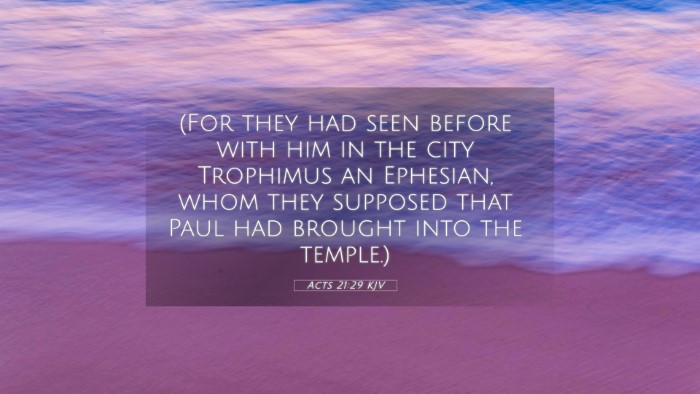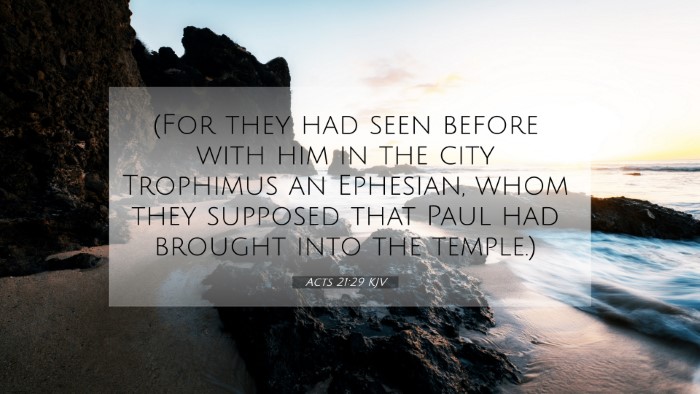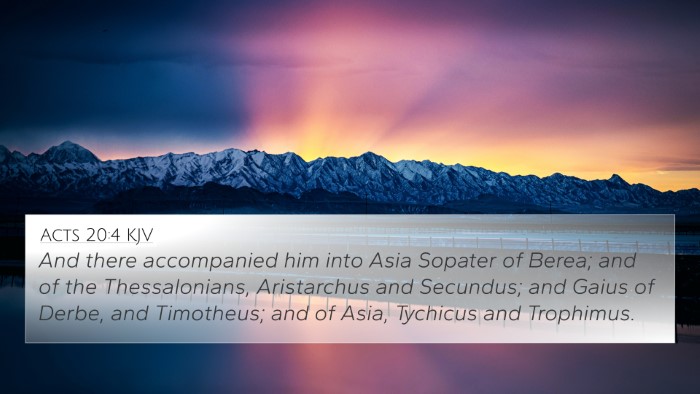Understanding Acts 21:29
Acts 21:29 states: "For they had seen before with him in the city Trophimus an Ephesian, whom they supposed that Paul had brought into the temple." This verse is situated in the context of Paul's journey to Jerusalem and the subsequent tumult that arose due to misinformation and prejudice against him.
Contextual Overview
This passage highlights a significant moment in the life of the Apostle Paul, showcasing the tensions between different cultural and religious identities. The mention of Trophimus, a Gentile, points to the growing clash between early Christians and traditional Jewish practices.
Insights from Public Domain Commentaries
-
Matthew Henry:
Henry emphasizes the misunderstandings faced by Paul during his ministry. His presence with Trophimus led to assumptions that he violated temple laws, showcasing the delicate line Paul walked between cultures.
-
Albert Barnes:
Barnes notes that the Jews wrongly concluded Paul had brought Trophimus into the temple, illustrating the dangers of prejudice and the impact of public perception on personal character and mission.
-
Adam Clarke:
Clarke elaborates on the significance of Trophimus' identity, suggesting that his presence with Paul acted as a catalyst for the uproar, revealing the complex interactions between Jewish and Gentile believers.
Thematic Connections
This verse is not only significant on its own but serves as a crucial link in the broader narrative of the New Testament. It underscores themes of misunderstanding, cultural conflict, and the early church's struggle for unity amidst diversity.
Bible Verse Cross-References
- Acts 21:27-28: The prior verses detail the accusations against Paul, setting the stage for the conflict introduced in verse 29.
- Acts 18:18: This verse references Paul’s earlier travels and church planting activities among Gentiles, illustrating his ongoing mission.
- Galatians 2:3-5: Paul defends the inclusion of Gentiles in the faith, providing theological background for the tensions faced in Acts 21.
- 2 Corinthians 11:24-26: Paul's sufferings for the gospel reflect the consequences of cultural and religious opposition.
- Ephesians 2:14: A pivotal verse discussing Christ's role in breaking down the walls between Jew and Gentile, paralleling the narrative in Acts.
- Romans 1:16: Paul emphasizes the gospel for all, irrespective of ethnic backgrounds, which contrasts with the Jewish exclusivism faced in Jerusalem.
- Acts 20:4: This verse lists Trophimus's earlier companions and the diverse cultural backgrounds within early Christian communities.
Exploring Cross-Referencing Biblical Texts
Cross-referencing Bible verses enriches our understanding of scripture. Through thematic Bible verse connections, we see how Acts 21:29 interacts with broader themes. Tools for Bible cross-referencing, such as concordances and guides, provide frameworks for understanding these relationships.
How to Use Bible Cross-References
Engaging with cross-references allows for a comparative Bible verse analysis, showcasing similarities and differences across texts. For example, understanding Paul's relationship with both Jewish and Gentile believers can be augmented by examining letters he wrote alongside the histories recorded in Acts.
Connecting Themes Across the Scriptures
Acts 21:29 serves as a microcosm of the tensions expressed throughout the New Testament. In exploring inter-Biblical dialogue, the connections elucidate how these conflicts influenced doctrinal development.
Bible Verse Parallels
Identifying parallels, such as the misunderstanding faced by Jesus in John 8:59, further illustrates the recurring theme of persecution arising from cultural and religious misinterpretations.
Conclusion
The story captured in Acts 21:29 speaks volumes about the conflicts that arose from cultural differences in the early church. By engaging in scriptural cross-referencing and thematic exploration, deeper insights into Paul's journey and the nature of early Christian identity can be obtained.
Further Study
For those interested in exploring cross-referenced themes in the Bible or developing a comprehensive Bible cross-reference system, various resources and study methods are available. Engaging with scripture through these lenses can greatly enhance personal Bible study and sermon preparation.





